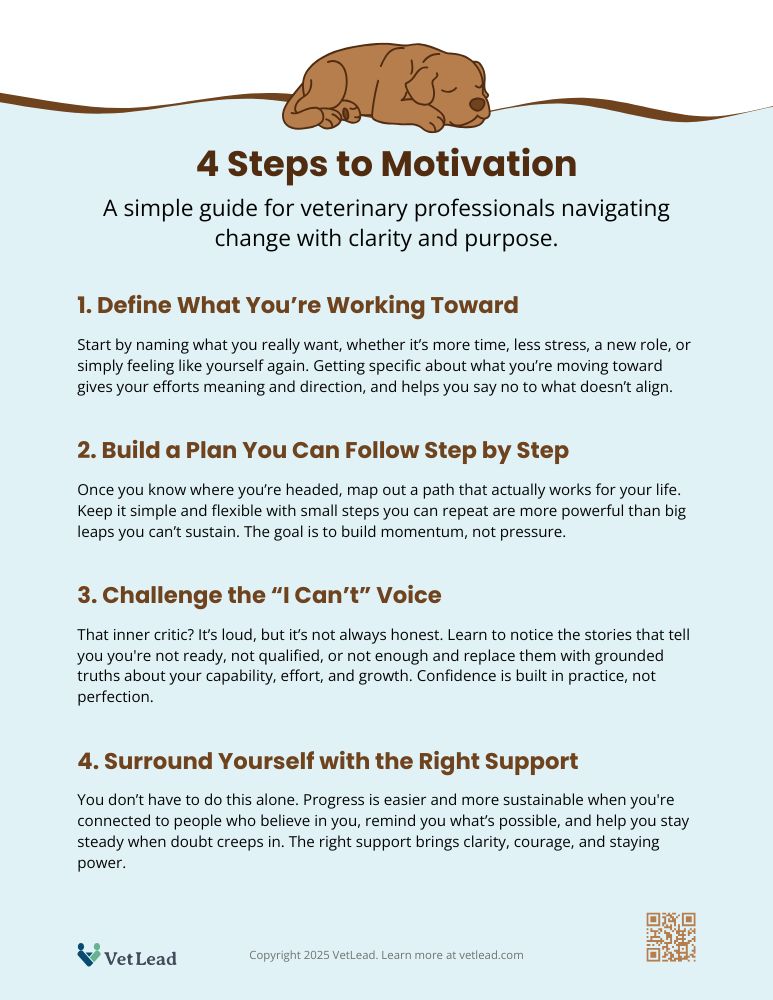Motivating a team is part of the job, but staying motivated yourself is what makes it possible.
It’s easy to focus on what your team needs: clarity, encouragement, direction. But leadership that lasts starts with what you need in order to show up consistently as the kind of leader you want to be.
Motivation isn’t a personality trait or a lucky streak. It’s a process that can be learned, practiced, and repeated.
The 4-Part Process to Keep Veterinary Leaders Motivated
Let's walk through four steps you can use to motivate yourself any time things feel unclear, overwhelming, or stalled. When you're motivated, you lead from a place of energy, not exhaustion, and that changes everything for your team, your culture, and your future.
1. Define What You’re Working Toward
Motivation begins with clarity. If you don’t know what you want, it’s nearly impossible to move toward it.
For veterinary leaders, that goal might look like becoming more organized, improving how you delegate, handling team conflict with more confidence, or just feeling less overwhelmed at the end of the day. But no matter the goal, the first step is to define it clearly, because our brains are wired to pursue what we can see, imagine, and emotionally connect with.
Wanting something vague like “a better day” or “less stress” won’t activate your motivation. Instead, picture your day running more smoothly because you created better appointment flow. Imagine your next team meeting actually feeling productive because you led it with intention. Visualize how that would impact your work, your team, and your practice.
Help Your Brain Want the Outcome
The more detail you give your brain, the more real the outcome starts to feel and the easier it becomes to want it.
Ask yourself:
- What would be different if I achieved this?
- How would my day, week, or life be better?
- Why does that matter?
Don’t rush this part. The goal here is to create a picture vivid enough that it becomes something you want to work toward, not something you should work on. When you connect your efforts to something meaningful, motivation stops being a struggle and starts becoming a habit.
2. Build a Plan You Can Follow Step by Step

Even when you want something, motivation can stall if you don’t know how to move forward. Uncertainty creates friction. And in busy veterinary practices, friction usually wins.
You don’t need a perfect plan to start. You just need a next step.
If your goal is to feel more in control of your day, that might mean reviewing your appointment schedule the night before. If you want to lead team meetings more confidently, the first step might be to jot down three things you want to communicate more clearly. If you're working toward better delegation, start by identifying one task you can hand off this week.
When you can identify the very next action, the path forward becomes manageable instead of overwhelming.
Start Small, Move with Intention
This is where motivation builds. Once you know your next move, you can apply the same “want” questions from earlier. What might be better if I do this? Why will it matter?
Then shift into planning: What will I need to make this step happen? When can I take it? What can I do today to follow through?
This process helps your brain build a mental map for how to get where you want to go. Each step you define and take creates momentum, which often matters more than motivation itself.
3. Challenge the “I Can’t” Voice
Even when you know what you want and how to start, your brain can still get in the way. That voice that says “this isn’t me” or “I’ll never be able to pull this off” is a real part of the leadership journey. And it’s not a sign that something’s wrong with you; it’s a sign that you’re trying something new.
The brain resists change, not because you’re weak or unmotivated, but because it hasn’t yet decided that the new thing is safe. Its job is to keep you comfortable, even if comfort is getting in the way of growth.
That’s why belief matters. If you don’t believe something is possible for you, you won’t move toward it, even if you want it and know what to do next.
Prepare for Opposition Before It Shows Up
One of the most effective things you can do is plan for that resistance. Expect it, then meet it with a better question.
Instead of shutting down when the doubt shows up, try redirecting it:
- I don’t have to get it perfect—what small version of this could I try?
- Is there something I could do that would help me feel more capable?
- What would progress look like today, not someday?
Belief grows when we take action, even small action. And it gets even stronger when we see others doing the things we want to do. If you’ve never led a team meeting, coached a struggling team member, or created a long-term hiring plan, look for examples of veterinary professionals who have. Their success isn’t proof you’re behind, it’s proof that growth is possible.
This step isn’t about tricking your brain. It’s about showing it that this new direction is safe, manageable, and worth trying. That’s how motivation gets stronger. And that’s how belief becomes something you build, not something you wait for.
4. Surround Yourself with the Right Support
Motivation fades fast in an environment that works against you. If you’re trying to lead change or grow as a leader, but everything around you reinforces the status quo, it becomes harder to stay committed.
That’s why the people, tools, and systems around you matter more than we often admit. Your environment can either make it easier to stay motivated or constantly drain your energy by creating friction.
Think about what support would look like if it were designed to help you succeed. If you want to coach more consistently, do you have time blocked to prepare for those conversations? If you're trying to stay more organized, is your space set up to make that easy? If you’re building new leadership habits, do you have someone you can talk to when things get hard?

4 Steps to Motivation
Download this PDF Now
Share it with other veterinary leaders and teams. No email address required.
Design an Environment That Helps You Move Forward
Support isn’t just about encouragement. It’s about setting up your world to reduce the barriers that wear you down. That includes your physical space, your schedule, your resources, and your people.
Motivation is easier to sustain when your surroundings are aligned with your goals. Maybe it’s a peer you check in with once a week. Maybe it’s a cleaned-up workspace that helps you think clearly. Maybe it’s a shared calendar with your team that makes delegation feel doable instead of chaotic.
Support also means creating an environment where it’s safe to grow. If your practice punishes mistakes instead of learning from them, people stop trying new things. That’s true for you, too. The more you normalize growth, experimentation, and small missteps, the easier it becomes to stay in motion.
Motivation doesn’t have to rely on willpower. When the right support is in place, it starts to feel more natural and far more sustainable.
Your Motivation Shapes the Future of Your Veterinary Practice
As a veterinary leader, your motivation influences how you lead, how you grow, and the kind of culture you build for your team. It’s more than staying energized. It means moving forward with clarity, confidence, and consistency.
You don’t have to wait to feel motivated. You can create it—by practicing four steps that work together:
- Define what you’re working toward
- Build a plan you can follow step by step
- Challenge the “I can’t” voice
- Surround yourself with the right support
This process isn’t about perfection. It’s about taking ownership of how you show up each day.
When you’re motivated, you lead with purpose. You make more thoughtful decisions. You create an environment where others feel motivated too.
Veterinary practices don’t improve just because someone works harder. They improve because someone chooses to lead better. And that choice starts with you.
What do you think? Other veterinary pros want to hear from you! Share your experience in the comments below.